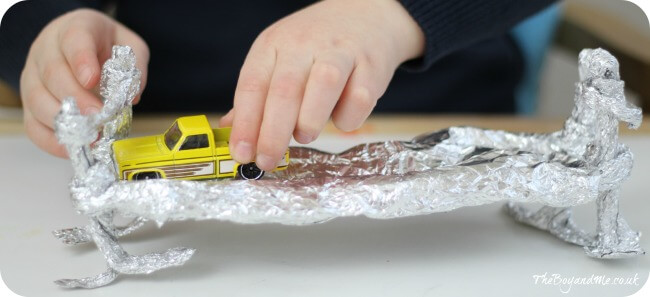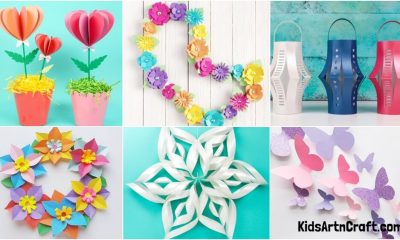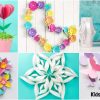DIY and Crafts
Stem Activities with Aluminum Foil

Introduce your students to the versatile material of aluminum foil with these easy and fun STEM activities. From engineering to chemistry, these activities will engage and challenge your students while they explore the many uses of aluminum foil. Welcome to this article about stem activities with aluminum foil! In this article, we will be exploring the various ways in which aluminum foil can be used in stem activities. Aluminum foil is a versatile material with many uses, making it a great choice for STEM activities. Whether you’re looking for a fun way to introduce kids to the basics of engineering or a creative way to explore the physical properties of metals, aluminum foil can provide a unique twist on many STEM activities. We’ll look at some of the ways aluminum foil can be used to make engineering and science experiments more engaging and fun. So, let’s get started!
Handmade Stem Activities With Aluminum Foil
 Read More: Bubble Wrap Crafts & Activities for Christmas
Read More: Bubble Wrap Crafts & Activities for Christmas
Easy Car Bridge Stem Activities with Aluminum Foil For Toddlers & Kids

Image Source/Tutorial: The Boy And Me
Simple Foil Boat & Penny Stem Activities For Toddlers & Kids

Image Source/Tutorial: Science Demo Guy
Quick & Easy Stem Activities with Aluminum Foil Raft Boat For Toddlers & Kids

Image Source/Tutorial: The Barefoot Home Schooling Mom
Tin Foil Rectangle Boat Stem Activities For Toddlers & Kids

Image Source/Tutorial: Jdaniel4s Mom
Stem Activities With Aluminum Foil Different Shapes Boat For Toddlers & Kids

Image Source/Tutorial: The Homeschool Daily
Read More: Scavenger Hunt Ideas For Kids
Aluminum Foil Sail Boat Stem Activities For Toddlers & Kids

Image Source/Tutorial: Jdaniel4smom
Fun And Easy Stem Activities with Aluminum Foil Row Boat For Toddlers & Kids

Image Source/Tutorial: Ship History
Cool Aluminum Foil Air Space Capsule Stem Activities For Toddlers & Kids

Image Source/Tutorial: Carly And A Dam
Circular Tin Foil Boat Stem Activities For Toddlers & Kids

Image Source/Tutorial: Little Bins For Little Hands
Awesome Aluminum Foil Snowman Stem Activities For Kids & Toddlers

Image Source/Tutorial: Preschool Steam
FAQs Related To Stem Activities with Aluminum Foil
1. What experiments can you do with aluminum foil?
Aluminum foil can be used for a variety of educational and entertaining experiments. For example, you can use it to make a pinhole camera and observe how light works. You can also use it to build a homemade Faraday cage and explore the principles of electricity. Aluminum foil is also great for creating a makeshift solar oven and can be used to conduct an experiment to measure the heating properties of different materials. Furthermore, you can use it to make a balloon hovercraft and explore the fundamentals of aerodynamics. Finally, aluminum foil is also great for creating a volcano and exploring the principles of chemical reactions. All in all, aluminum foil is an incredibly versatile material that can be used to conduct a variety of science experiments.
2. What happens when you put aluminum foil in water?
When aluminum foil is placed in water, a reaction occurs that produces hydrogen gas. This is because aluminum is a highly reactive metal and when it comes in contact with water, it reacts with the oxygen and hydrogen in the water to form aluminum hydroxide and hydrogen gas. This reaction is exothermic and can create enough heat to ignite the hydrogen gas, creating a spark and a small explosion. This reaction is not recommended as it can be dangerous and should only be done with proper safety precautions.
3. What happens when you mix vinegar and aluminum foil?
When vinegar, an acidic liquid, is mixed with aluminum foil, a reaction takes place that produces hydrogen gas. This reaction is caused by the aluminum foil reacting with the acetic acid in the vinegar. The hydrogen gas created is a flammable gas and can be ignited with a lighter or match. This reaction is an example of a single replacement reaction, where the acetic acid in the vinegar replaces the hydrogen in the aluminum foil. This reaction can be used as a science experiment for children to learn about chemical reactions.
4. Does lemon juice react with aluminum foil?
Yes, lemon juice can react with aluminum foil. This is because lemon juice is acidic and aluminum foil is made from a metal, so when the two come into contact with each other, a reaction occurs. The reaction produces hydrogen gas, which causes bubbles to form on the surface of the aluminum foil. This reaction can be used to demonstrate the principles of chemistry and the reactivity of metals with acids. In addition, the reaction between lemon juice and aluminum foil can be used in various DIY projects such as creating a makeshift battery.
5. When should you not use aluminum foil?
Aluminum foil is a great tool for many different types of cooking or baking, but there are some instances where its use should be avoided. Aluminum foil should not be used in the microwave, as it can cause sparks and even fires. Additionally, when cooking in the oven, aluminum foil should not be placed directly on the oven floor, as it can cause a fire hazard. When using aluminum foil with acidic foods such as tomatoes, it should only be used to cover the food so that it is not in direct contact with the foil. Finally, it is important to avoid using aluminum foil on non-stick surfaces, as it can cause scratching and damage the coating.
6. What is the difference between tin foil and aluminum foil?
Tin foil and aluminum foil are similar in that they are both thin sheets of metal that can be used for cooking, wrapping food, and a variety of other purposes. The main difference between the two is that tin foil is made from tin, which is a soft metal, while aluminum foil is made from aluminum, which is a much stronger and durable metal. Tin foil is more malleable and can be folded, while aluminum foil is stiffer and doesn’t bend as easily. Tin foil is also more prone to tearing, while aluminum foil is more resistant to tears. Tin foil also has a shorter shelf life than aluminum foil, and its shiny surface can cause light to reflect off of it, which can be a nuisance in some situations.
7. Is aluminum foil toxic when heated?
When it comes to cooking, aluminum foil is a common household item used for various purposes. However, many people often wonder if aluminum foil is toxic when heated. The answer is both yes and no. While it is true that aluminum foil can leach aluminum into your food when heated, the amount is generally considered to be very small and not enough to cause any significant health risks. As long as you don’t use aluminum foil at very high temperatures, you should be safe from any potential health risks.
8. What are the disadvantages of foil?
One of the primary disadvantages of foil is that it is not very environmentally friendly. Foil is made from aluminum, which is a non-renewable resource that is not easily recycled. Additionally, foil is not heat-resistant, meaning it should not be used over high heat or in the oven, as it can easily melt or catch fire. It is also not safe to use in the microwave, as it can create sparks and even cause fires. Foil is also not very durable and can easily tear, making it difficult to reuse or store. Finally, foil can be dangerous to use if not handled carefully, as it can cause cuts and other injuries.
Aluminum foil can be a great tool for engaging kids in stem activities. With its versatility and wide range of applications, it can be used to teach and reinforce a variety of topics related to science, technology, engineering, and math. Follow us on Youtube for art and craft tutorials and much more.
More Articles from Kids Art & Craft
- Magnet Experiments for 3rd Grade
- Piggy Projects Ideas For Kids
- Stem Activities with magnets
- Air Dry Clay Ideas For Toddlers
- Bubble Wrap Sensory Activities For Toddlers















